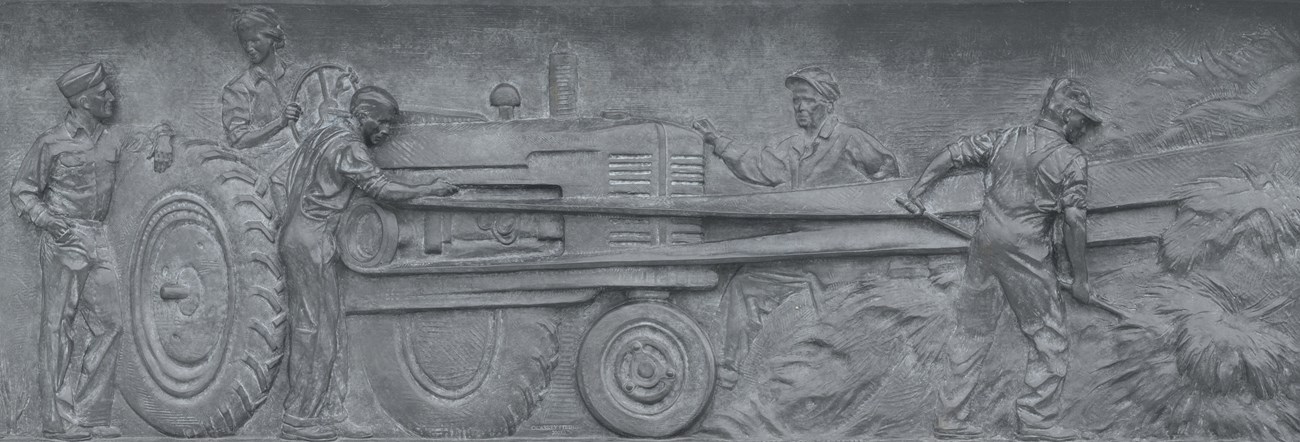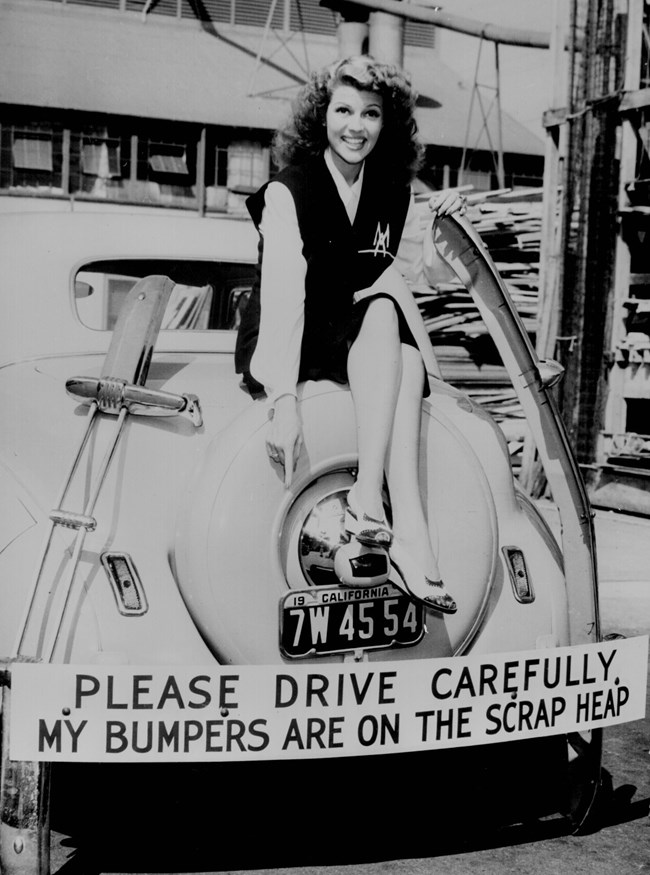Last updated: April 24, 2020
Article
The World War II Home Front

An extremely important, but sometimes overlooked, aspect of World War II was America’s overwhelming home front effort. While many countries around the world were dealing with the destruction and chaos of the war, the U.S. had many opportunities to help the allied forces with the war being fought away from its shores.
This effort is prominently represented in the World War II Memorial on the National Mall. Each of the 56 memorial’s columns that represent the states and territories that existed during the war is decorated with two wreaths. A wreath made of wheat represents agricultural output and the wreath of oak leaves represents industrial productivity, the two pillars of the American home front effort. Additionally, a number of the bas-relief panels that line the ceremonial entrance of the memorial depict scenes from the American home front, including shipbuilding, a war bonds drive, and agricultural production (above).
Realizing that a massive amount of food was needed to feed the troops, farmers from across the country went into full-production mode. Shipment after shipment was sent overseas to feed the hungry soldiers. So in demand was the food that it quickly became clear food rationing would have to take place within the United States. Never ones to shy away from a challenge, Americans across the country began planting “victory gardens.” Twenty million of these victory gardens popped up around the country and accounted for 40% of the vegetables consumed within the U.S.
By 1942, the U.S. had put an extensive rationing program into place. The government began putting limits on much needed supplies. Civilians were issued ration stamps that were used for family allotments of vegetables, fruit, meat, gas, rubber, and even clothing. Americans worked hard not to waste any essentials. So involved was the country in this effort that citizens conducted recycling drives to collect scrap metal, cans, rubber, and many other items that could be used for constructing military weapons, ammunition, tanks, jeeps and ships. On the National Mall, rationing even affected the newly constructed Thomas Jefferson Memorial, dedicated in 1943. Due to wartime metal shortages, the central statue of Jefferson was originally cast in plaster. The current bronze version on display wasn’t installed until 1947, when rationing was lifted.
This effort is prominently represented in the World War II Memorial on the National Mall. Each of the 56 memorial’s columns that represent the states and territories that existed during the war is decorated with two wreaths. A wreath made of wheat represents agricultural output and the wreath of oak leaves represents industrial productivity, the two pillars of the American home front effort. Additionally, a number of the bas-relief panels that line the ceremonial entrance of the memorial depict scenes from the American home front, including shipbuilding, a war bonds drive, and agricultural production (above).
Realizing that a massive amount of food was needed to feed the troops, farmers from across the country went into full-production mode. Shipment after shipment was sent overseas to feed the hungry soldiers. So in demand was the food that it quickly became clear food rationing would have to take place within the United States. Never ones to shy away from a challenge, Americans across the country began planting “victory gardens.” Twenty million of these victory gardens popped up around the country and accounted for 40% of the vegetables consumed within the U.S.
By 1942, the U.S. had put an extensive rationing program into place. The government began putting limits on much needed supplies. Civilians were issued ration stamps that were used for family allotments of vegetables, fruit, meat, gas, rubber, and even clothing. Americans worked hard not to waste any essentials. So involved was the country in this effort that citizens conducted recycling drives to collect scrap metal, cans, rubber, and many other items that could be used for constructing military weapons, ammunition, tanks, jeeps and ships. On the National Mall, rationing even affected the newly constructed Thomas Jefferson Memorial, dedicated in 1943. Due to wartime metal shortages, the central statue of Jefferson was originally cast in plaster. The current bronze version on display wasn’t installed until 1947, when rationing was lifted.

War Bond drives were another important aspect of the U.S. home front effort. Bond rallies were a very common sight during the war and parades were held across the country to raise money. So popular were these bond drives that 85 million Americans (over half of the population) purchased $185 billion dollars of bonds. That is over $2000 per person, when the average American salary was only $2000 a year.
This all-inclusive home front effort involved great sacrifice from every American citizen. This patriotic effort was so instrumental in pulling the country together and helping win the war that it is often credited for empowering American soldiers and leaving the enemy awestruck. For these reasons, the home front effort is proudly represented within the World War II Memorial.
